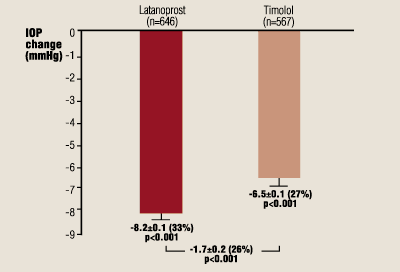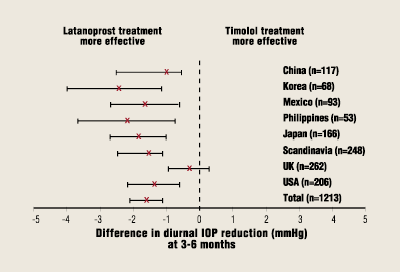Global studies find latanoprost more effective than timolol
Meta-analysis of eight studies finds 1.7-mm Hg difference in IOP lowering between the two drugs.
UPPSALA, Sweden — Latanoprost (Xalatan, Pharmacia Corp.) reduced diurnal intraocular pressure (IOP) significantly more than timolol, according to a meta-analysis of eight global randomized trials, said Katarina Hedman, MSc, of Pharmacia Corp., who compiled the results with Lill-Inger Larsson, MD, PhD, of the department of ophthalmology of the University Hospital, in Uppsala, Sweden.
Researchers performed a meta-analysis of eight randomized global clinical studies to make a direct comparison of the IOP-reducing effect of latanoprost 0.005% once daily and timolol 0.5% twice daily in a global population.
Eight global trials
 ---Diurnal IOP
reduction (mean±sem) at 3 to 6 months compared with
baseline.
---Diurnal IOP
reduction (mean±sem) at 3 to 6 months compared with
baseline.
SOURCE:
KATARINA HEDMAN, MSC
Researchers collected data on 1,213 patients
who were evenly split between open-angle glaucoma (OAG) and ocular
hypertension. Most had never had any previous glaucoma treatment.
Study groups included 117 Chinese patients, 68 Koreans, 93 Mexicans, 53 Filipinos, 166 Japanese, 248 Scandinavians, 262 patients from the United Kingdom and 206 patients from the United States.
Studies in the United Kingdom, United States, Scandinavia, Japan and the Philippines were double-masked. Studies in Mexico, Korea and China were open label. Treatment time in the United Kingdom, United States and Scandinavia was recorded at 6 months, and treatment time was recorded at 3 months in all other countries.
Patients were at least 18 years old in the Philippines, Mexico, Korea and China, between 20 and 75 years old in Japan and more than 40 years old in the United States, United Kingdom and Scandinavia. All patients had an IOP of at least 22 mm Hg with or without treatment in all trials except in Mexico, where OAG patients had at least 22 mm Hg and ocular hypertension patients had at least 27 mm Hg. In Japan, IOP had to be between 21 mm Hg and 30 mm Hg after the wash-out period.
For the 646 latanoprost patients, the mean age was 60.5±13.6 years (mean ± SD), with a range of 19 to 92. Gender was evenly split. Of the patients, 370 were white, 201 were Asian, 50 were Hispanic and 25 were black.
 ---Percentage of
diurnal IOP reduction from baseline at 3 to 6 months.
---Percentage of
diurnal IOP reduction from baseline at 3 to 6 months.
SOURCE: KATARINA HEDMAN, MSC
In this group, 323 had ocular hypertension, 286 had OAG, 33 had
exfoliation glaucoma and four had pigmentary glaucoma. The mean untreated
baseline IOP was 24.8±4.3, with a range of 16 to 63. Most had no
previous treatment, while 99 had previous monotherapy, 50 had unknown therapies
and 23 had multiple therapies.
Among the 567 timolol patients, the mean age was 60±13.9 years, with a range of 18 to 95. Gender was split evenly. Among the group, 278 were white, 204 were Asian, 52 were Hispanic and 33 were black.
In this group, 376 had no previous therapy, 114 had received monotherapy, 52 had unknown therapies and 25 had multiple therapies.
At baseline, overall untreated IOP was 24.8±4.33 mm Hg (mean ± SEM) for the latanoprost group and 24.2±3.5 mm Hg for the timolol group. After 3 to 6 months of treatment, IOP was reduced 8.2±0.1 mm Hg with latanoprost (33%, P <.001) and 6.5±0.1 mm Hg with timolol (27%, P <.001), which was a statistically significant difference.
An IOP reduction of 30% or more was achieved by 60% of the latanoprost-treated patients and by 34% of the timolol-treated patients (27%, P <.001). The difference between groups of –1.7 mm Hg ±0.2 mg Hg (26%) was found to be statistically significant (P <.001).
Latanoprost vs. timolol
 ---Mean difference in
diurnal IOP reduction from baseline with 95% confidence interval.
---Mean difference in
diurnal IOP reduction from baseline with 95% confidence interval.
SOURCE: KATARINA
HEDMAN, MSC
“Latanoprost was more effective in all the
separate studies, with a less pronounced difference in the United Kingdom of
0.3 mm Hg and a larger difference in Korea of 2.6 mm Hg,” Dr. Hedman said.
“Latanoprost reduced diurnal IOP significantly more than timolol in a
globally widespread population. Performing a meta-analysis of studies from
different countries strengthens the conclusion that the treatment effects are
similar regardless of ethnic origin.”
Latanoprost was effective in black, Asian, white and Hispanic patients. It reduced diurnal IOP, a mean of morning, noon and afternoon measurements, by 26% more than timolol. The result was clinically and statistically significant (P <0.001). However, results varied between some countries because of trial-specific differences and random variation.
“At this point in the research, the meta-analysis has not yet assessed the IOP-reducing effect in subgroups of the country-specific trials,” Dr. Hedman said. “Further research can show if previous treatment with different drugs affects the IOP reduction, or if any other recorded baseline characteristics have an influence on the IOP reduction.”
For Your Information:
- Katarina Hedman, MSc, can be reached at UF13-2, Pharmacia Corporation, S-751 82 Uppsala, Sweden; +(46) 18-16300; fax: +(46) 18-166375. Dr. Hedman is a statistician at the Pharmacia Corp. Dr. Lill-Inger Larsson is a paid consultant for Pharmacia.
